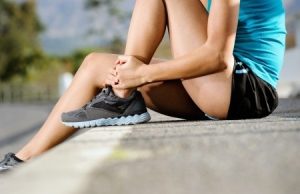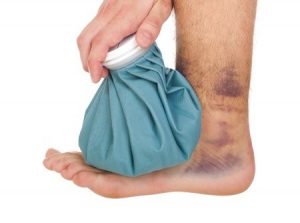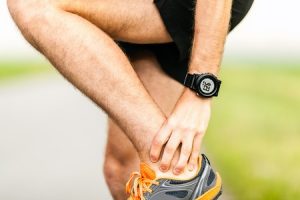
Photo credit: 123RF / Warrengoldswain
When the weather warms up, most people tend to get more active, whether it’s walking around the neighborhood, running in a 5K, playing a round of golf or hiking in a park. People like to get outside and keep healthy. However, activities like these can put a lot of stress on your feet and ankles which can cause acute or overuse injuries. But do you know the difference between these types of foot and ankle injuries?
Acute Foot and Ankle Injuries
An acute foot and ankle injury typically occurs suddenly. You may become injured from a direct blow or something puncturing your foot or ankle. You may injure your foot or ankle by twisting, jerking, jamming or bending it abnormally. Some acute injuries include:
- Fracture – A broken bone.
- Puncture wound – A sharp object like a nail or tack pierces the skin, muscles and/or ligaments.
- Sprain – An injury to a ligament (tissue that connects two or more bones at a joint). A sprain may involve one or more ligaments that are stretched or torn.
- Strain – An injury to a muscle or tendon (tissue that connects muscle to bone). During a strain, the muscle or tendon may be stretched or torn.

Photo credit: 123RF / Luis Santos
Some signs of an acute foot and ankle injury are:
- Sudden, severe pain.
- Bruising.
- Swelling.
- Muscle spasms or weakness.
- Dislocation or a bone that’s moved out of place.
- Inability to walk or bear weight on your foot or ankle.
Overuse Foot and Ankle Injuries
An overuse injury refers to damage to a bone, muscle, ligament or tendon that occurs from “overdoing” an activity or repeating the same activity over time without allowing enough time for the body to heal. Some foot and ankle injuries due to overuse include:
- Achilles tendinitis – An overuse injury of the Achilles tendon, the band of tissues that connects your calf muscles at the back of your lower leg to your heel bone.
- Plantar fasciitis – Inflammation of the plantar fascia, a broad, flat ligament on the bottom of your foot that extends from the front of your heel to the base of your toes. The plantar fascia helps maintain the arch of your foot.
- Metatarsalgia – Inflammation and pain in the ball of your foot.
- Retrocalcaneal bursitis – Inflammation of the bursa located in the back of your ankle by your heel. It is where the Achilles tendon connects your calf muscles to your heel bone.
- Stress fracture – A hairline crack in a bone.

Photo Credit: 123RF / Blazej Lyjak
Some signs of overuse foot and ankle injuries are:
- Swelling.
- Redness.
- The area is warm to the touch.
- Impaired use of your foot or ankle.
- Pain and/or stiffness, especially in the morning.
- Pain that continues to get worse.
Diagnosis and Treatment of Acute and Overuse Foot and Ankle Injuries
If you suspect you have an acute or overuse injury in your foot or ankle, schedule an appointment with your doctor. If you have severe pain, swelling, redness, bruising, and/or difficulty walking after an injury, see a doctor immediately. Your doctor can determine the extent of your injury and develop a treatment plan which may include rest, ice, over-the-counter and prescription medications, elevating your leg, physical therapy, a cast or splint, or surgery.
How to Prevent Acute and Overuse Foot and Ankle Injuries
Some ways you can prevent acute and overuse injuries to your feet and ankles include:
- Wear the proper shoes for your sport that are comfortable and provide you with the correct support. Refer to the WalkEZStore’s Shoe Fitting Guide to make sure your shoes fit properly. Replace athletic shoes yearly. Running shoes should be replaced every 300 to 400 miles.
- Wear custom orthotics, like ezWalker® Custom Fit Orthotics, ezRunner® Performance Fit Orthotics or ezCycler® Breakaway Fit Orthotics, for your sport. WalkEZStore custom orthotics help correct biomechanical imbalances from your feet up. They also provide your feet with the proper support and unloading of painful ligaments or muscles to give your body a greater chance to heal from overuse injuries. For more information on WalkEZStore custom orthotics, visit WalkEZStore.com. To purchase a pair of our custom orthotics, visit our online store.
Because … when your feet feel good, you feel good.®
Disclaimer: The information included in this article is for educational purposes only. It should not be used as a substitute for professional medical advice, diagnosis or treatment.

